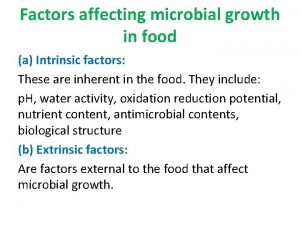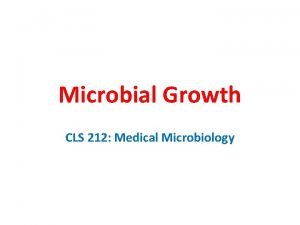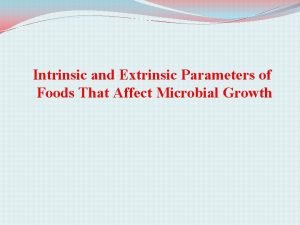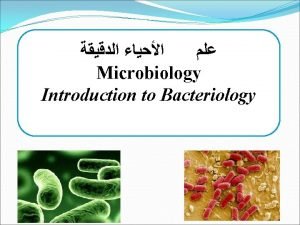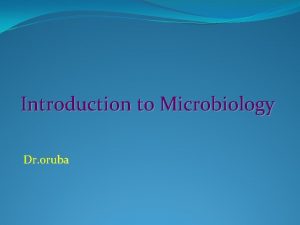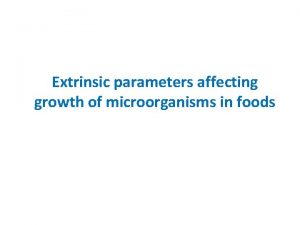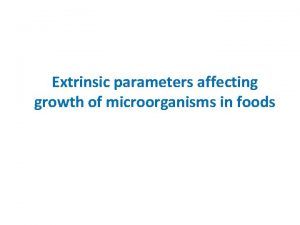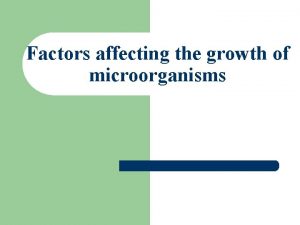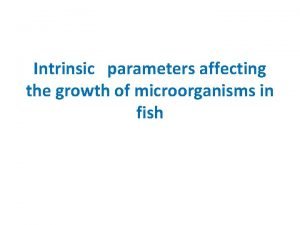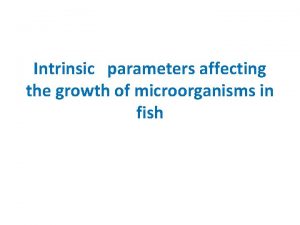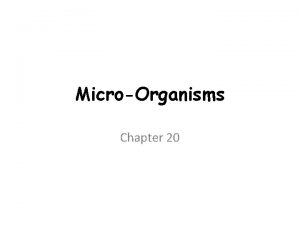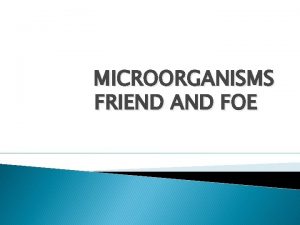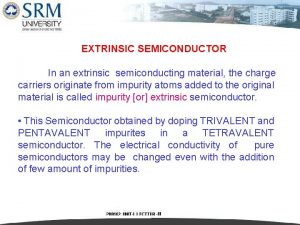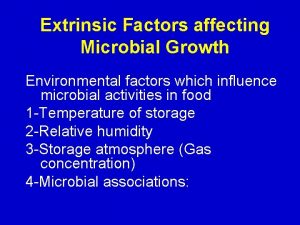Extrinsic parameters affecting growth of microorganisms in foods

















- Slides: 17

Extrinsic parameters affecting growth of microorganisms in foods

• Extrinsic parameters - properties of the environment to which the food is exposed • Includes - characteristics of the storage environment of the food • The intrinsic factors of the food are influenced by the conditions of storage environment, and there by affect the quality of food • The environmental factors which have influence on the food associated microorganisms are; -Storage temperature - Relative humidity of storage environment - Presence or absence of gases - Presence and activities of other microorganisms

1. Temperature of storage • Storage temperature - temperature at which the food is handled and stored • Selecting a proper temperature for the storage of different food types helps in maintaining quality • Each microorganism exhibits minimum, optimum and maximum temperature at which growth occurs-cardinal temperature • This temperature is characteristic for an organism and is influenced by factors such as nutrient availability, p. H of growth medium, water activity etc.

Grouping of microorganisms based on temperature requirement for growth Microorganisms are grouped in to 4 broad types based on cardinal temperature Groups Minimum temperature for growth (0 C) Optimum temperature for growth (0 C) Maximum temperature for growth (0 C) Psychrotrophs -5 to +5 25 -30 30 -35 Psychrophiles -5 to +5 12 -15 15 -20 Mesophiles 5 -15 30 -40 40 -47 Themophiles 40 -45 55 -75 60 -90

Psychrophiles: • Microrganisms capable of growing at low temperature - psychrophiles. • Divided in to 2 types based on their optimum temperature for growth- 1. Obligate psychrophiles (cold loving) –Temperature optima - 12 -150 C, unable to grow above 200 C; Confined to polar regions and deep marine environment 2. Psychrotrophs (facultative psychrophiles) - Minimum temperature- as psychrophiles; have higher optimum and maximum growth temperature; found in most diverse habitats, grow well in refrigerated temperature and cause spoilage of chilled food Ex: Alcaligenes, Cornybacterium, Flavobacterium, lactobacillus, Pseudomonas, Enterococcus etc. • These bacteria grow well at 5 -70 c (refrigerator temperature ) and cause spoilage of meat, fish, poultry, eggs etc.

Mesophiles: • Normal temperature conditions of 30 -400 C • Mesophiles grow quickly at their optimum temperature than psychrotrophs • The spoilage of food at mesophilic temperature range is rapid than at chill temperature Thermophiles: • High temperature loving microorganisms with the optimum temperature in the range of 55 - 750 C • Thermophilic spore formers of the genus Bacillus and Clostridium cause spoilage of canned foods

Molds and yeasts: • Wide temperature range; some at refrigerated temperature (Aspergillus, Cladosporium, Thamnidium Sp). • Yeasts - psychrophilic and mesophilic temperature Storage temperature and spoilage: • Temperature of storage is most important parameter affecting the spoilage of highly perishable foods (Ex. fish) • Maintaining all foods at refrigerated temperature is not advisable as it affects the quality of food. • Ideal temperature for storage of most vegetables is 100 c , banana: 13 -170 c

2. Relative humidity (RH) • Relative humidity of the food storage environment refferes to percentage of moisture present in the atmosphere • RH and water activity are closely related and RH is measure of aw of the gas phase of atmosphere RH = 100 x aw

Effect of RH on food being stored: • RH of storage environment influences aw of foods and growth of microorganisms on food surface • Foods of low aw stored in high RH environment leads to transfer of water from environment to the food, increasing aw of food until equilibrium is reached • Condensation of moisture on food - high aw on surface and subsurface • This favors growth of microorganisms • Foods of high aw when stored in low RH environment lose moisture, become flaccid and unfit for consumption due to loss of quality

RH and spoilage of food - As the temperature increases RH decreases - Foods that are susceptible for spoilage by yeasts, molds and certain bacteria should be stored under low RH conditions. - Wrapped animal meat kept in refrigerator (high RH) undergone surface spoilage. - Selection of suitable RH condition for storage is necessary to avoid surface microbial growth and maintain desirable qualities of food as food may lose/take up moisture under improper RH condition and lose its quality

Presence and concentration of gases in the environment • Exposure of foods to gases in the storage environment (gaseous environment) affects growth and survival of microorganisms in foods • Exposure to oxygen - growth of aerobic microorganisms • Gaseous environment need to be modified to ensure reduced microbial activity and resultant spoilage • Commonly employed in the preservation of fruits and vegetables.

Gases used to control microorganisms in foods • Carbon dioxide, ozone and nitrogen - to control microorganisms in food • Ready to eat foods –to extend shelflife of packed foods - Modified Atmosphere Package (MAP) foods • Carbon dioxid- important to control microorganisms in foods; used in varying concentration • Carbon dioxide in elevated pressure - used in carbonated water and soft drinks • Molds and Gram negative microorganisms are more sensitive to CO 2 than Gram positive bacteria • Lactobacilli are resistant to CO 2. Yeasts show considerable resistance and tolerate high CO 2 level but can cause spoilage of carbonated beverage (Ex. Brettanomyces sp. )

Mechanism of inhibition: • Carbon dioxide - acts as bacteriostatic agent • Mechanism of inhibition of CO 2 is due to the formation of carbonic acid which lowers p. H • Lowered p. H affects physical properties of plasma membrane of microorganisms and affects solute transport, inhibits key enzymes, and reacts with amino group of proteins causing changes in their property and activity • Ozone (03) - has antimicrobial properties and extends shelf life of certain fruits and vegetables foods • O 3 concentration of 0. 15 -5 ppm is known to double the shelf life by inhibiting spoilage bacteria and yeast

Presence and activities of other microorganisms • The nature of microorganisms (microbial associations) encountered in foods can affect microflora of food which are called implicit factors. These include - properties of organisms present in food - response of these organisms to their environment - interaction with other organisms in food

Effect of activities of microorganisms on food microflora; • Among several organisms present in food, microorganisms which find condition suitable (in food) for growth dominate over other organisms. Ex. Molds can grow on dry fish, but slowly, than bacteria. • In fresh fish bacteria overgrow molds as conditions are most favourable. Faster growing bacterial growth is inhibited by low aw or low p. H where moulds grow and cause spoilage • Some food borne microorganisms produce metabolite /substances such as antibiotics, bacteriocins, hydrogen peroxide, organic acids etc which are inhibitory /lethal to other microorganisms

• Spoilage microorganisms can interact wherein growth of one favours the growth of others. Ex: In low aw food (grain) growth of few molds increases aw leading to growth of other xerophilic molds. • One organism may increase nutrient availability to others by degrading complex food substrates to simple forms. • Some microorganisms may remove inhibitory substances thereby permit the growth of others.

 Intrinsic factors affecting microbial growth
Intrinsic factors affecting microbial growth Factors affecting bacterial growth ppt
Factors affecting bacterial growth ppt Extrinsic parameters of food
Extrinsic parameters of food Hypothalamus hormones
Hypothalamus hormones Factors affecting microbial growth in food
Factors affecting microbial growth in food Factors affecting bacteria growth
Factors affecting bacteria growth Factors affecting entrepreneurial growth
Factors affecting entrepreneurial growth Step growth polymerization vs chain growth
Step growth polymerization vs chain growth Neoclassical growth theory vs. endogenous growth theory
Neoclassical growth theory vs. endogenous growth theory Primary growth and secondary growth in plants
Primary growth and secondary growth in plants Organic growth vs inorganic growth
Organic growth vs inorganic growth Growth analysis
Growth analysis Primary growth and secondary growth in plants
Primary growth and secondary growth in plants Pith
Pith Geometric exponential growth
Geometric exponential growth Are microorganisms helpful or harmful
Are microorganisms helpful or harmful Classification of microorganisms
Classification of microorganisms Microorganisms species
Microorganisms species
